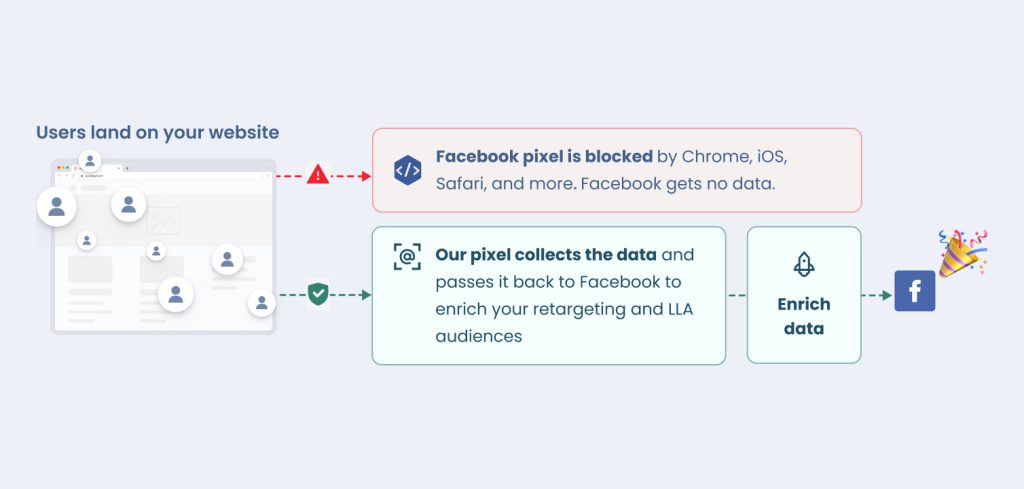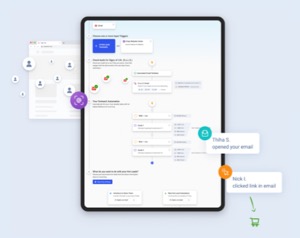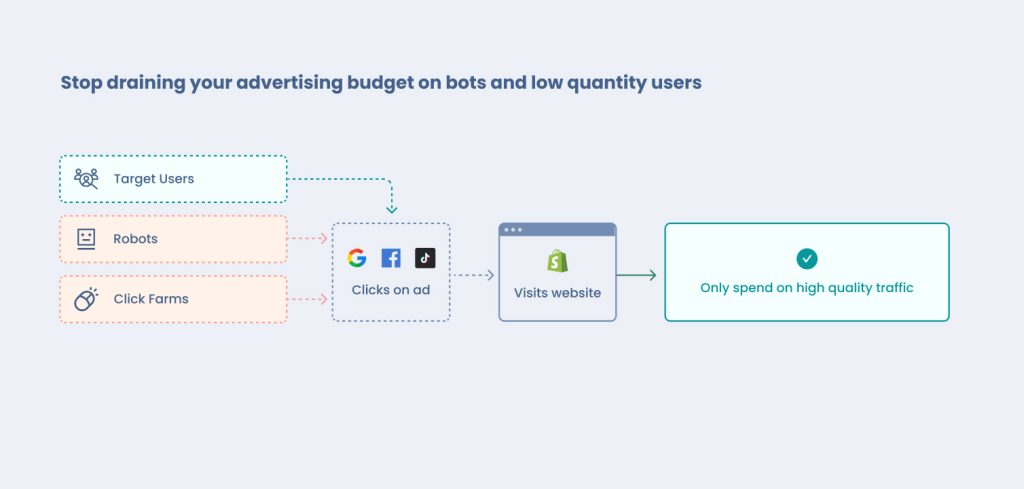With all the changes happening in the world of Facebook advertising, staying ahead requires more than just a basic understanding of ad placements and targeting.
As technology evolves and privacy concerns continue to intensify, advertisers tasked with maximizing ROI must continuously refine their approaches.
This means going beyond the basics and focusing on things like advanced segmentation and targeting, AI and machine learning for optimization, creative testing, and more.
The thing is, we know how much potential there is in the Facebook ecosystem, it’s why we are an official Meta partner. When done right, advertisers can see really exceptional results.
So let’s dive in and look at how we can maximize performance and take our Facebook ad strategies to the next level.
Convert Website Visitors into Real Contacts!
Identify who is visiting your site with name, email and more. Get 500 contacts for free!
Advanced Segmentation and Targeting
We are big fans of segmentation here at Customers.ai.
After all, detailed audience segmentation allows advertisers to create and deliver highly relevant content to specific audiences. By looking at demographics, interests, behaviors, and more, you can significantly increase engagement rates and improve overall campaign effectiveness.
Seems like a good thing right?
There are several ways you can add advanced segmentation strategies to your ad campaigns. Let’s look at three: Custom Audiences, Lookalike Audiences & Advantage+ Audiences.
Custom Audiences
Custom audiences are created from existing data on your customers (think email lists or users who have previously interacted with your content).
While Facebook is pushing advertisers to Advantage+, we think custom audiences are way more valuable. After all, they are YOUR audience.
And with the right data, you can create fantastic segments with highly targeted creative. This includes:
- Website Traffic: Create custom audiences from users who have visited specific pages of your website. For example, with the Customers.ai Website Visitor ID X-Ray pixel, you can identify over 20% of site visitors, even if they don’t give you their information. That data can then be used to retarget individuals on Facebook. With Restore, you can get an even higher match rate (check out this post).
- Engage Past Customers: No one wants a one and done buyer. Target users who have previously made a purchase with ads for related products or exclusive offers. Is it time for a refill? Is there an update on the product they purchased? Get creative and make your segments work for you.
- Segment by Intent: We know that not every buyer is ready to make a purchase. That’s ok! That’s what ads are for. The ads for visitors who hit the shopping cart should be much different than the ads for visitors who hit the T-Shirts page. By being able to track which pages your users visit, you can create really specific segments based on intent.
Lucky for you, our tools make all of this not just possible, but easy. Including our customer journey mapping feature which shows you all the pages your buyer visited.

And our Facebook integration which allows you to send audiences directly to your Facebook campaigns:

Lookalike & Advantage+ Audiences
Lookalike audiences allow you to reach new people whose interests and behaviors are similar to those of your existing customers while Advantage+ audiences use Meta’s advanced AI to build your campaign audience.
The thing with both of these audiences is that they are only as good as the data you populate them with.
So whether you are still using lookalike audiences or have made the switch to Advantage+, you want to keep the following in mind:
- Start with a High-Quality Source Audience: You want to reach those most likely to buy right? That means your source audience must be people who…you guessed it, bought! Use your best-performing customer segments, such as those with high engagement or conversion rates, as the basis for creating lookalike audiences or informing your Advantage+ audiences.
- Specify Audience Size and Similarity: In the case of lookalike audiences, size matters. While Facebook generally recommends a source audience between 1,000-5,000 people, smaller audiences can actually perform better. For Advantage+ audiences, more data is usually better. The more data you can “train” Facebook’s AI with, the better.
- Update and Refine: Like anything in marketing, it’s important to continuously update and refine your source audiences to ensure your segments remain relevant and effective.
Whatever kind of audience you decide on (maybe all of them!), segmentation not only elevates the efficiency of your ad spend but also drives superior conversion rates by aligning your content with the distinct needs and interests of each audience segment.

See Who Is On Your Site Right Now!
Get names, emails, phone numbers & more.
Try it Free, No Credit Card Required
Leveraging AI and Machine Learning for Optimization
AI and machine learning are revolutionizing how Facebook ad campaigns are optimized.
We’re talking automated bidding processes, campaign data analysis, and real-time campaign optimization. AI algorithms can predict outcomes based on historical performance and real-time data, adjusting bids in milliseconds to maximize ad visibility and engagement.
These dynamic capabilities ensure that advertisers not only reach their target audience more effectively but also optimize their ad spend, reducing CPA and increasing ROI.
Here are a few examples of how AI is being used (and can be used) in Facebook advertising:
- Dynamic Creative Optimization: AI can be used to automatically test different combinations of ad elements such as images, videos, headlines, descriptions, and CTAs. By analyzing the performance data in real-time, the system identifies the most effective combination for each segment of the audience. Even if you aren’t doing dynamic ad creation, AI tools can be really helpful for creative.
- Predictive Analytics for Audience Targeting: Facebook uses AI to analyze data on things like user behavior, preferences, and engagement patterns. This analysis helps predict which users are most likely to take a specific action (think making a purchase, clicking on a link, or engaging with content) and ensures ads are shown to these particular people.
- Audience Expansion: We already touched on how AI is driving audience expansion above but it’s worth noting just how big of an impact this is now having in ads. With iOS 14 and now the loss of cookies, Facebook audiences have shrunk dramatically. AI is helping Facebook (and you) to build back those audiences and ensure targeting capabilities don’t completely fade away.
AI is here to stay and as and advertiser, you can use it to your advantage or you can let your competitors use it to their advantage.
Creative Testing and Iteration
Testing isn’t exactly an “advanced” technique in the general sense. However, the process of creative testing can be.
Testing allows you to understand which elements of your ads resonate most and it allows you to see results quicker.
Let’s look at a few creative testing strategies:
- A/B Testing: At its core, A/B testing is simple – compare two versions of an ad and see which performs better. The key here is variable isolation; change one element at a time—be it the image, headline, ad copy, or CTA—while keeping all other variables constant. By doing it this way, you can get clear insights into which specific changes improve ad performance.
- Multivariate Testing: For a more comprehensive analysis, multivariate testing lets you test multiple variations of several elements at once. While it can be a bit more challenging, this approach can show how different elements interact with one another and their combined effect on ad performance. The key to multivariate testing is a large audience and statistically significant results.
- Sequential Testing: Sequential testing involves giving your audience a series of ad variations over time. While more time-consuming than A/B testing, this strategy can be particularly useful for understanding how changes in creative elements impact ad fatigue and engagement over longer campaigns. The goal – figuring out the optimal frequency and timing for refreshing ad creatives.
In the analysis phase, having the right tools in place is key. Whether it’s Facebook’s analytics tools or third-party platforms, you will need something to understand ad performance and test results.
By prioritizing creative testing and iteration, advertisers can significantly enhance the effectiveness of their Facebook ads. This cycle of analysis and iteration ensures that ad strategies remain dynamic, targeted, and continually optimized.
Making Facebook Ads Work for You
As we said earlier, there is so much potential in Facebook Ads. I think sometimes we forget there is actually a whole Meta ecosystem of Facebook, Instagram, WhatsApp, and Messenger, giving us multiple places to reach our audience.
But we won’t be successful if we rely on old strategies.
In order to make Facebook ads work for you, you must go beyond the basics. We need advanced segmentation and targeting, we need to capitalize on AI technology, and we certainly need to remember to test, test, test.
And if you really want to go above and beyond, you need Customers.ai.
Our Restore product can skyrocket your Facebook reach and allow you to target website visitors you had no idea existed.

Want to learn more? Try it free or contact our sales team for more information.
Convert Website Visitors into Real Contacts!
Identify who is visiting your site with name, email and more. Get 500 contacts for free!
Important Next Steps
- See what targeted outbound marketing is all about. Capture and engage your first 500 website visitor leads with Customers.ai X-Ray website visitor identification for free.
- Talk and learn about sales outreach automation with other growth enthusiasts. Join Customers.ai Island, our Facebook group of 40K marketers and entrepreneurs who are ready to support you.
- Advance your marketing performance with Sales Outreach School, a free tutorial and training area for sales pros and marketers.
Advanced Facebook Ads Strategy FAQs
Q. How do I use lookalike audiences to improve Facebook ad targeting?
Lookalike audiences can be created by leveraging the characteristics of your existing customers or high-value users to target new users with similar behaviors and interests, effectively expanding your reach to a more relevant audience.
Q. What strategies can enhance the performance of my Facebook video ads?
Optimizing video ads involves creating engaging content within the first few seconds, using captions for silent viewing, and tailoring the video length to your campaign objectives and audience preferences.
Q. How does the Facebook pixel improve ad targeting and conversion tracking?
The Facebook pixel collects data about user actions on your website, enabling you to create targeted ads based on this activity and measure the effectiveness of your advertising by tracking conversions.
Q. Can I use AI and machine learning to optimize my Facebook ad campaigns?
Yes, AI and machine learning can automate bidding strategies, optimize ad placements, and personalize content, improving efficiency and ad performance.
Q. What are the best practices for A/B testing Facebook ads?
Best practices include testing one variable at a time, using a statistically significant audience size, running the test for an adequate duration, and analyzing results based on clear KPIs.
Q. How do custom audiences work, and how can they improve my ad campaigns?
Custom audiences allow you to target ads to users based on your own data, such as email lists or users who have interacted with your content, leading to more personalized and effective advertising.
Q. What impact do privacy regulations have on Facebook ad targeting?
Privacy regulations like GDPR and CCPA limit how advertisers can collect and use data, necessitating more reliance on first-party data and privacy-compliant targeting methods.
Q. How can I leverage Facebook’s dynamic creative feature for my ads?
Dynamic creative automatically tests different combinations of your ad components, identifying the most effective variation for different audience segments.
Q. What are the advantages of using Facebook’s Campaign Budget Optimization (CBO)?
CBO automatically distributes your campaign budget across ad sets to favor the best-performing ones, improving overall campaign efficiency and ROI.
Q. How can cross-platform advertising be effectively managed within the Facebook ecosystem?
Effective management involves understanding the unique attributes of each platform, maintaining a consistent brand message across all, and using unified metrics for comprehensive performance analysis.
Q. What techniques can be used to combat ad fatigue on Facebook?
Techniques include regularly refreshing ad creative, targeting new audience segments, and utilizing dynamic ads to keep content fresh and engaging.
Q. How does Facebook Attribution help in measuring ad performance across devices and channels?
Facebook Attribution provides cross-device and cross-platform tracking, offering insights into the customer journey and the impact of different marketing efforts on conversions.
Q. How can I optimize ad delivery for specific conversion events?
By setting up custom conversion events in Facebook Ads Manager, you can tailor your ad delivery strategies to prioritize these actions, optimizing your campaigns for higher conversion rates.
Q. What role does video play in advanced Facebook ad strategies?
Video content is crucial for capturing attention, engaging audiences, and improving ad performance, especially when optimized for mobile viewing and designed to convey the message even without sound.
Q. How can I ensure my Facebook ads are GDPR compliant?
Ensuring compliance involves obtaining explicit consent for data collection, being transparent about data use, and providing options for users to view, edit, or delete their data.
Q. How do I use Facebook’s ad relevance diagnostics to improve my campaigns?
Ad relevance diagnostics provide insights into the quality, engagement, and conversion rates of your ads, allowing you to identify areas for improvement and optimize for better performance.
Q. What strategies can I employ to increase the click-through rate (CTR) of my Facebook ads?
Strategies include using compelling visuals, clear and actionable CTAs, personalized ad copy, and targeting improvements to make your ads more relevant to your audience.
Q. How can I use Facebook Insights to refine my advertising strategy?
Facebook Insights offers detailed analytics on your ad performance and audience demographics, helping you make informed decisions about creative content, targeting, and campaign adjustments.
Q. What is the significance of ad placement optimization in Facebook advertising?
Ad placement optimization ensures your ads appear in the locations most likely to drive engagement and conversions, whether on Facebook, Instagram, Audience Network, or Messenger.
Q. How can retargeting campaigns on Facebook increase conversions?
Retargeting campaigns target users who have previously interacted with your brand, reminding them of their interest and nudging them towards conversion with personalized ads.
Q. What are the best practices for creating effective Facebook ad copy?
Effective ad copy is concise, focused on benefits, includes a clear call to action, and is tailored to the target audience’s interests and needs.
Q. How does the use of emojis affect Facebook ad engagement?
Emojis can increase engagement by adding personality and emotion to your ad copy, making it more relatable and attention-grabbing, but should be used judiciously to match your brand tone.
Q. Can Facebook ads drive both online and offline conversions?
Yes, Facebook ads can drive both by using online campaigns to increase web conversions and using offline conversion tracking to measure the impact of ads on in-store visits and purchases.
Q. How do I measure the ROI of my Facebook advertising campaigns?
Measuring ROI involves tracking conversion events attributed to your ads, calculating the revenue generated from these conversions, and comparing it against your ad spend.
Q. What are the challenges of international Facebook advertising, and how can they be overcome?
Challenges include language barriers, cultural differences, and varying legal regulations. Overcoming these requires localized content, cultural sensitivity, and adherence to local laws.
Q. How can storytelling be incorporated into Facebook ad campaigns?
Storytelling can be incorporated through sequential ad placements that narrate a brand story across multiple interactions, engaging users and building a deeper connection.
Q. What is the importance of mobile optimization for Facebook ads?
With the majority of Facebook users accessing the platform via mobile, optimizing ads for mobile ensures better user experiences, higher engagement rates, and improved ad performance.
Q. How can I utilize Facebook Groups in my ad strategy?
Facebook Groups can be targeted through ads to engage with niche communities and foster a sense of belonging, but it’s important to respect group norms and contribute value.
Q. What strategies can be employed to lower the cost per acquisition (CPA) on Facebook ads?
Lowering CPA involves optimizing targeting, ad creative, and bidding strategies, as well as focusing on high-conversion actions and refining audience segments.
Q. How does the choice of Facebook ad format impact campaign success?
The ad format should align with campaign objectives, whether it’s driving engagement, conversions, or brand awareness, as different formats offer varying benefits for specific goals.
Q. How can advanced segmentation enhance Facebook ad campaigns?
Advanced segmentation allows for precise targeting based on detailed criteria, ensuring ads are shown to the most relevant audience, improving engagement, and conversion rates.
